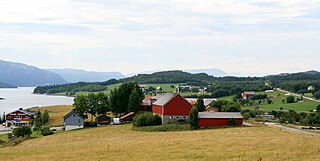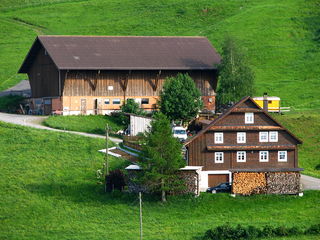
Oppdal (help·info) is a municipality in Trøndelag county, Norway. It is part of the Dovre region and the traditional district of Orkdalen. The administrative centre of the municipality is the village of Oppdal. Other villages in the municipality include Lønset, Vognillan, Fagerhaug, and Holan. The Oppdal Airport, Fagerhaug is located in the northeastern part of the municipality.

Malvik is a municipality in Trøndelag county, Norway. It is part of the Trondheim Region. The administrative center of the municipality is the village of Hommelvik. Other villages in Malvik include Muruvika, Smiskaret, Sneisen, Vikhammer, and Hundhammeren.

The Norwegian University of Science and Technology is a public research university with campuses in the cities of Trondheim, Gjøvik, and Ålesund in Norway, and has become the largest university in Norway, following the university merger in 2016. NTNU has the main national responsibility for education and research in engineering and technology, originated from Norwegian Institute of Technology (NTH). In addition to engineering and natural sciences, the university offers higher education in other academic disciplines ranging from social sciences, the arts, medical and life sciences, teacher education, architecture and fine art. NTNU is well known for its close collaboration with industry, and particularly with its R&D partner SINTEF, which provided it with the biggest industrial link among all the technical universities in the world.

Trondheim Airport, Værnes is an international airport serving Trondheim, a city and municipality in Trøndelag county, Norway. The airport is located in Værnes, a village in the municipality of Stjørdal in Trøndelag county, 10 nautical miles east of Trondheim. Operated by the state-owned Avinor, it shares facilities with Værnes Air Station of the Royal Norwegian Air Force. In 2014, the airport had 4,416,681 passengers and 60,934 air movements, making it the fourth-busiest in the country. The airport has two terminals; A dates from 1994 and is used for domestic traffic, while B is the renovated former main terminal from 1982, and is used for international traffic. The airport features a main east–west 2,999-metre (9,839 ft) runway, a disused northwest–southeast 1,472-metre (4,829 ft) runway, an integrated railway station and an airport hotel.

Vangshylla is a village in the municipality of Inderøy in Trøndelag county, Norway. It is located at the southwest end of the Inderøya peninsula in the Utøy area, surrounded on two sides by the Trondheimsfjord. The village sits at the southern end of the Skarnsund strait. Until 1991, when the Skarnsund Bridge opened, Vangshylla served as a ferry and fishing port. Since 1964, it was served by the Vangshylla–Kjerringvik Ferry. It has since been converted into a marina and tourist center with rental accommodation for fishing in Skarnsund.

Higher education in Norway is offered by a range of eight universities, nine specialised universities, 24 university colleges as well as a range of private university colleges. The national higher education system is in accordance with the Bologna process, with bachelor's degrees, master's degrees and doctoral degrees. Acceptance is offered after finishing upper secondary school with general university admissions certification.
Norwegian College of General Sciences or AVH is a former Norwegian college which from 1968 to 1996 was part of the University of Trondheim (UNIT). It was created as the Norwegian College of Teaching in Trondheim (NLHT) in 1922, a name which it retained until 1984. In 1968 it became part of the new university in Trondheim, but in practice it retained much of its former autonomy. The college received its final name in 1984. In 1996 it was merged with the rest of the university to create the new Norwegian University of Science and Technology (NTNU).

The NTNU University Museum in Trondheim is one of seven Norwegian university museums with natural and cultural history collections and exhibits. The museum has research and administrative responsibility over archaeology and biology in Central Norway. Additionally, the museum operates comprehensive community outreach programs and has exhibits in wooden buildings in Kalvskinnet.
The Royal Norwegian Society of Sciences and Letters is a Norwegian learned society based in Trondheim. It was founded in 1760 and is Norway's oldest scientific and scholarly institution. The society's Protector is King Harald V of Norway. Its membership consists of no more than 435 members elected for life among the country's most prominent scholars and scientists.

Lade Airport was an air station and later civilian airport located at Lade in Trondheim, Norway which was in use from 1940 to 1965. It had a 1,140-meter (3,740 ft) concrete runway.
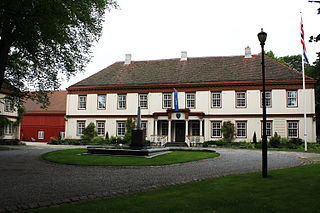
Lade Manor is the site of one of the historic farms of Norway. It is located in the community of Lade outside the city of Trondheim.

Nord-Trøndelag was a county constituting the northern part of the present-day Trøndelag county in Norway. The county was established in 1804 when the old Trondhjems amt was divided into two: Nordre Trondhjems amt and Søndre Trondhjems amt. In 2016, the two county councils voted to merge (back) into a single county on 1 January 2018.

Værnes Air Station is an air station of the Royal Norwegian Air Force located in the municipality of Stjørdal in Trøndelag county, Norway. It is co-located with Trondheim Airport, Værnes, which is owned and operated by Avinor. As an air station, the aerodrome is primarily used for the Marine Corps Preposition Program Norway, which involves the United States armed forces stationing equipment at Værnes and other facilities in the Trondheim region of central Norway. The Værnes military installations contain place for up to six aircraft of the size of a C-5 Galaxy and barracks to house 1,200 soldiers. It also serves the Home Guard, including its training center and the headquarters of the Trøndelag District (HV-12). Formerly, the air force's pilot school was located at Værnes.
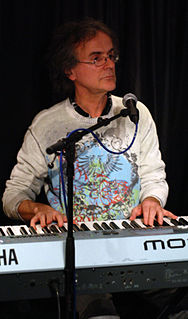
Henning Sommerro is a Norwegian musician, composer and professor at NTNU.

Trondheim Airport, Jonsvatnet was a water aerodrome located at Valset on the lake of Jonsvatnet in Trondheim, Norway. The airport was built as the first permanent airport serving Trondheim and initially was used for Norwegian Air Lines' (DNL) routes which commenced in 1935. Ahead of the 1936 season the airport was equipped with permanent installations, including wharfs and a small terminal building. In 1937 the airport was used by Widerøe, before DNL returned the following year.

Leangen Travbane is a harness racing course located at Leangen in Trondheim, Norway. The race course is owned by the Norwegian Trotting Association and its parimutuel betting is handled by Norsk Rikstoto. Through this arrangement it is the only equine tote betting establishment in Trøndelag and Møre og Romsdal.

Vestlandske Luftfartsselskap A/S, trading internationally as West Norway Airlines, was a airline based in Bergen, Norway, which operated from 1946 to 1957. The company operated almost entirely a fleet of seaplanes out of its base at Bergen Airport, Sandviken. From 1951 it operated scheduled services along the West Coast as summer-only services.
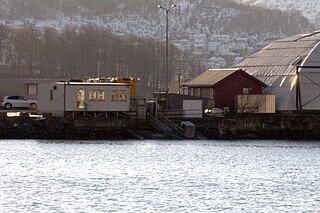
Bergen Airport, Sandviken is a water airport and heliport situated in the Sandviken neighborhood of Bergen, Norway. The aerodrome is located on the artificial peninsula of Kristiansholm. It is currently serving seaplanes and helicopters operated by Fonnafly aimed at air taxi services at cruise ship tourists. The airport is owned by Bergen Municipality through Bergen Port Authority and is part of the Bergen Port. Operations are carried out by Fonnafly.

